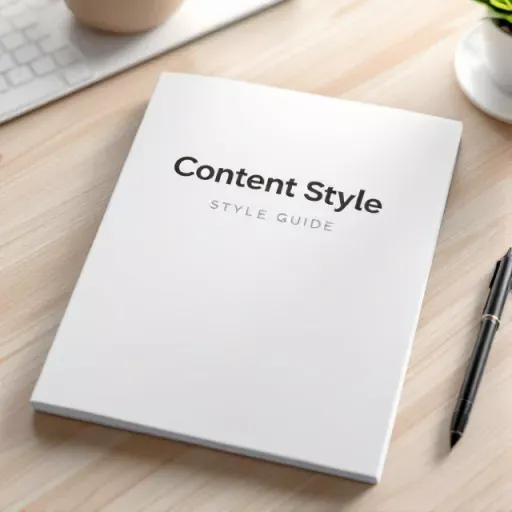Why Every Small Business Needs a Content Style Guide
Running a small business is a bit like spinning plates—there’s always something to keep an eye on. With so many moving parts, it’s easy for your brand’s voice to get lost in the shuffle. That’s where a content style guide comes in. Think of it as your brand’s playbook for writing, design, and communication. It helps everyone on your team stay on the same page, whether you’re posting on social media, sending out emails, or updating your website.

A style guide isn’t just for big companies. In fact, it’s even more important for small businesses, where resources are tight and every message counts. When your content looks and sounds consistent, you build trust with your audience. People start to recognise your brand, and that recognition can turn casual browsers into loyal customers.
What Is a Content Style Guide?
A content style guide is a document that sets out the rules for how your business communicates. It covers everything from the words you use to the colours in your logo. The goal is to make sure that no matter who’s creating content—whether it’s you, a staff member, or a freelancer—it all feels like it’s coming from the same place.
Your style guide can be as simple or as detailed as you like. Some businesses keep it to a single page, while others go all out with a full manual. The key is to make it clear, practical, and easy to use.
The Benefits of a Content Style Guide
Let’s break down why a style guide is a smart move for your small business:
1. Consistency Builds Trust
When your content looks and sounds the same everywhere, people start to trust your brand. They know what to expect, and that makes them more likely to stick around.
2. Saves Time and Reduces Confusion
With clear guidelines, you won’t have to answer the same questions over and over. New team members can get up to speed quickly, and you’ll spend less time fixing mistakes.
3. Supports Brand Recognition
A consistent style helps your business stand out. Whether someone sees your Instagram post or reads your newsletter, they’ll know it’s you.
4. Makes Collaboration Easier
If you work with freelancers or agencies, a style guide gives them a clear roadmap. You’ll get content that matches your brand, without endless back-and-forth.
5. Improves Quality
When everyone follows the same rules, your content is more polished and professional. That can make a big difference in how people see your business.
What to Include in Your Content Style Guide

Ready to put your guide together? Here’s what you should cover:
1. Brand Voice and Tone
Start by describing your brand’s personality. Are you friendly and casual, or more formal and serious? Give examples of the kind of language you want to use—and what to avoid. For instance, if you’re a local café, you might want a warm, welcoming tone. If you’re a law firm, you might prefer clear and professional language.
Tip: Include a few sample sentences to show the difference between “on-brand” and “off-brand” writing.
2. Grammar, Spelling, and Punctuation
Decide on the basics:
- Will you use Australian English spelling (like “optimise” and “colour”)?
- Do you prefer the Oxford comma?
- Are there words or phrases you want to avoid?
Setting these rules upfront keeps your content tidy and consistent.
3. Formatting Guidelines
How should headings look? What about bullet points, lists, or quotes? Set out rules for things like:
- Heading styles (e.g., H1 for titles, H2 for subheadings)
- Paragraph length
- Use of bold or italics
- How to handle links
This helps your content look neat and easy to read, no matter who’s writing it.
4. Visual Style
Your guide should also cover the visual side of things. Include:
- Logo usage (where and how to use it)
- Brand colours (with hex codes or Pantone numbers)
- Fonts and typography
- Image guidelines (e.g., photo style, use of stock images, image sizes)
If you have templates for social media or email, link to them here.
5. Approved Messaging and Taglines
List your main messages, taglines, or slogans. This ensures everyone uses the same phrases when talking about your business.
6. Examples and Templates
Show real examples of good content. Include templates for things like blog posts, emails, or social media updates. This makes it easier for others to follow your lead.
7. SEO and Keywords
If you want your content to be found online, include a section on SEO best practices. List your main keywords, explain how to use them naturally, and set rules for things like meta descriptions and alt text for images.
For more on SEO basics, check out Moz’s Beginner’s Guide to SEO.
How to Create Your Content Style Guide
You don’t need fancy software or a big budget to get started. Here’s a step-by-step approach:
Step 1: Gather Your Existing Content
Look at what you’ve already published—your website, social media, emails, and ads. What do you like? What feels off? Use this as a starting point for your guide.
Step 2: Define Your Brand Voice
Think about your business’s personality. Are you chatty and fun, or more reserved? Write down a few words that describe your style. Then, jot down some sample sentences that capture your voice.
Step 3: Set the Rules
Decide on your grammar, spelling, and formatting preferences. Be specific, but keep it simple. The goal is to make your guide easy to follow.
Step 4: Add Visual Guidelines
Include your logo, colours, and fonts. If you have a designer, ask them for the official files and codes. If not, use free tools like Coolors to pick a colour palette.
Step 5: Create Templates and Examples
Templates save time and help everyone stay consistent. Make a few for your most common content types—like blog posts, social media updates, or newsletters.
Step 6: Share and Update
Once your guide is ready, share it with your team. Save it somewhere easy to find, like Google Drive or Dropbox. Update it as your business grows or your style changes.

Tips for Keeping Your Style Guide Useful
- Keep it short and sweet. A long, complicated guide is less likely to be used.
- Use real examples. Show what good content looks like for your brand.
- Update regularly. As your business changes, so should your guide.
- Ask for feedback. Your team might spot things you’ve missed.
Common Mistakes to Avoid
- Being too vague. “Write in a friendly tone” isn’t enough. Give clear examples.
- Ignoring visuals. Your brand’s look is just as important as its voice.
- Letting it gather dust. A style guide only works if people use it. Remind your team to check it often.
- Not involving your team. Get input from everyone who creates content. They’ll have useful ideas and spot gaps.
Free Tools and Resources
You don’t have to start from scratch. Here are some handy resources:
- Canva’s Brand Kit for managing logos, colours, and fonts.
- Mailchimp’s Content Style Guide for inspiration.
- Australian Government Style Manual for local spelling and grammar rules.
Real-World Example: A Local Florist’s Style Guide
Let’s say you run a small flower shop. Your brand is cheerful, local, and a bit cheeky. Here’s how your style guide might look:
- Voice: Friendly, playful, and a little bit cheeky.
Example: “Brighten someone’s day with a bunch of blooms—no green thumb required!” - Spelling: Australian English (e.g., “favourite,” “organise”).
- Formatting: Use short paragraphs, lots of white space, and bold for key points.
- Visuals: Soft pastel colours, hand-drawn illustrations, and photos of real bouquets.
- Templates: Instagram post template with your logo in the corner, email template with a friendly greeting.
With these rules in place, every piece of content feels like it’s coming from the same friendly florist—no matter who’s writing it.
Wrapping Up: Your Next Steps
A content style guide isn’t just a nice-to-have—it’s a must for any small business that wants to look professional and build a strong brand. It doesn’t have to be complicated. Start small, keep it practical, and update it as you go.
By setting clear rules for your words and visuals, you’ll save time, avoid confusion, and make your business stand out. Plus, you’ll give your customers a brand they can recognise and trust.
Ready to get started? Grab a notebook, jot down your brand’s personality, and start building your guide today. Your future self—and your customers—will thank you.


